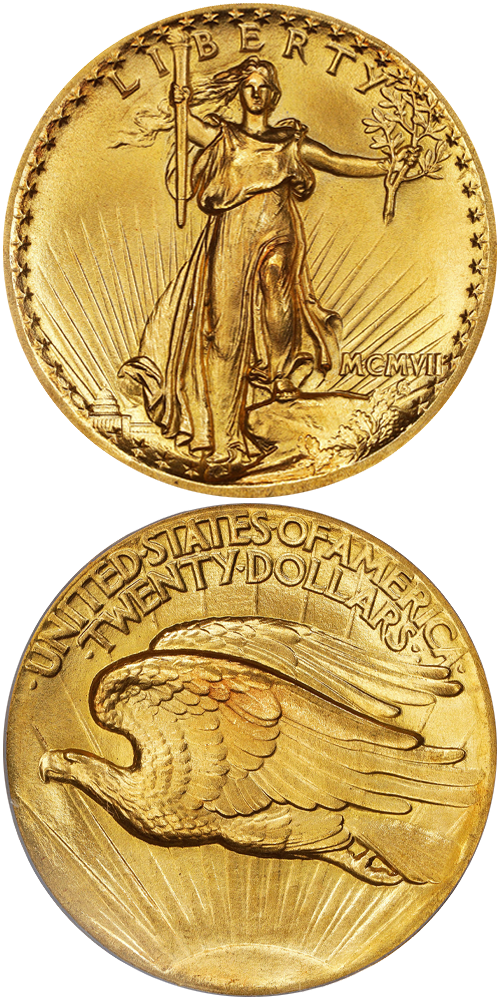1907 Saint Gaudens Double Eagle
Wire Rim
The High Relief Saint-Gaudens double eagle is one of those coins that appear on most numismatist's wish lists even if 20th century American gold is not a chosen field of study. The image of Liberty striding towards the viewer holding a torch and olive branch is one of the most familiar coin motifs and is recognizable by even those with the most casual interest in coins.
The MCMVII High Relief double eagle has long been celebrated as one of the most beautiful coin designs in all of American numismatics. The story of its creation and the partnership between president and sculptor adds to the appeal of the novel design. In 1905, President Teddy Roosevelt, arguably the president who took the most active and personal interest in our coinage designs, was sadly disappointed with the mediocre appearance of America's coinage designs of the era. The president had only recently taken an interest in ancient Greek coins, having just seen some on display, and he vocally lamented the fact that the coinage of his "bully pulpit" era was mainly plain and uninspired in comparison to those ancient works of numismatic art. Accordingly, Roosevelt contracted with his long time acquaintance, Augustus Saint-Gaudens, paying the sum of $5,000 to him to redesign the entire U.S. coinage spectrum, from the small bronze cent all the way up to the large gold double eagle. Saint-Gaudens, America's most admired sculptor, kept his studio and family home in Cornish, New Hampshire, where he prepared the many sketches and working models for his ideas. By the summer of 1907, Saint-Gaudens had nearly completed the work on the Indian $10 design as well as the new $20 design (which was based on his statue of Victory, part of the Sherman Victory Monument which stands proudly today in New York City's Central Park). On August 3, 1907, Saint-Gaudens succumbed to cancer without having seen an example of his work in its legal tender form; his stunning design was finished by his assistant, Henry Hering. Meanwhile, a great "war" of words and bombast (Roosevelt called it his "pet crime") had broken out between the Mint and Charles Barber on one side, and the "Ol' Rough Rider," President Roosevelt, on the other. Barber was gravely upset that Roosevelt had unkind words for his dime, quarter, and half dollar designs (which had circulated as current coin of the realm since 1892), and he was also incensed over the fact that an outside artist had been chosen to redesign our country's coinage. Further, Barber protested that the high relief of the dies would prevent the coins from striking, stacking at banks, and on and on, causing Roosevelt to state that the MCMVII $20 coins would be produced if it took all day to strike just one coin!
Despite Barber's shenanigans, the MCMVII High Relief double eagles were eventually produced to the tune of several hundred pieces a day, though not without difficulties - each coin needed three blows from the dies to be rendered to its full design advantage. In time, however, some 11,250 High Relief MCMVII double eagles were produced to the president's satisfaction. Barber then redesigned the dies, making them flatter in depth and considerably less dynamic in appearance, and swapping the Roman numerals for Arabic. This style would continue through the demise of the series in 1933.
When the High Relief coins were released through the sub-treasuries and large banking institutions, the coins were eagerly acquired and received almost universal acclaim. Very few entered circulation but rather were retained as pieces of numismatic art and very quickly premiums were attached to the coins, up to $30 per piece. As interest waned in the 1920s, the coins carried little if any premium and many did light duty in circulation, and some likely ended up in the great Treasury melts of the 1930s. The High Relief coins became more popular starting in the 1940s and have maintained their position near the top of any collector's wish list ever since. As testimony to the timeless nature of Saint-Gaudens' design, it is by no mere coincidence that it was selected for the American Eagle gold bullion coins in 1986.
While about half of the original production are extant, demand far outstrips supply. Fortunately, Mint State examples are available and are especially desirable at the Choice level. For the numismatist seeking to add an example of the High Relief issue, the Flat Rim specimens offer both scarcity and beauty, being more challenging to acquire than their Wire Rim counterparts.
The example to the left was sold by Stack's Bowers Galleries in the August 2023 Global Showcase Auction, where it realized $288,000.






